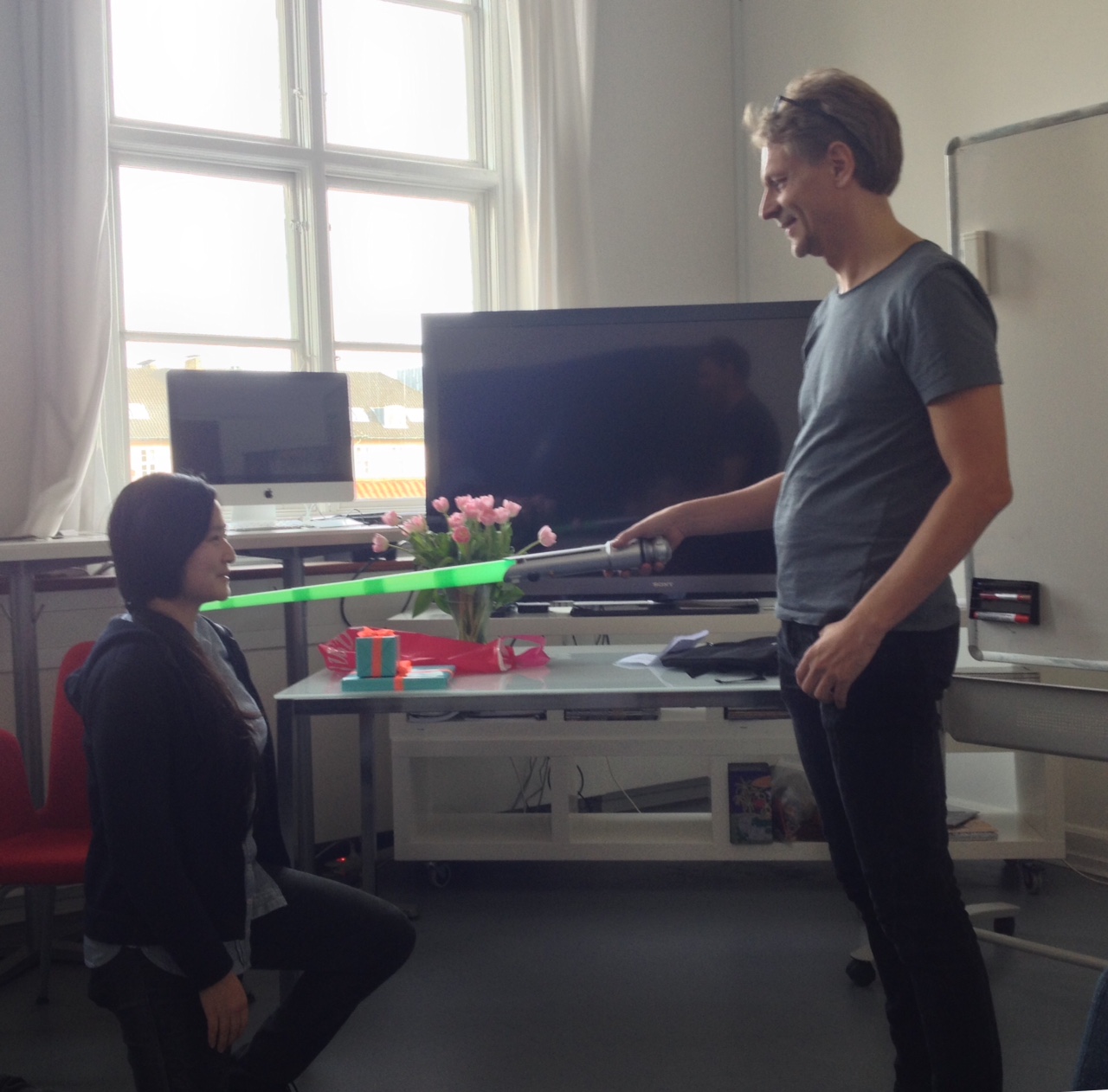Congratulations to Xue Li
Xue Li successfully successfully defended her PhD thesis "Exploring Cosmology with Supernovae - A study of supernovae and their applications" on Thursday, 30 October 2014. Xue has been working at DARK with supervisor Jens Hjorth.
 Abstract: The most intriguing aspect of studying supernovae associated with gamma-ray bursts (GRB-SNe) is the fact that they are accompanied by the most energetic events in the uni- verse: gamma-ray bursts (GRBs). GRBs are extremely bright, which makes a swift trigger of observation on them. Therefore, a supernova (SN) light curve following a GRB can be detected. In addition, GRB-SN rate does not decline beyond z > 1.5, which is a fun- damental feature to breakdown degeneracies in the constraint on the equation of state parameter ω(z).
Abstract: The most intriguing aspect of studying supernovae associated with gamma-ray bursts (GRB-SNe) is the fact that they are accompanied by the most energetic events in the uni- verse: gamma-ray bursts (GRBs). GRBs are extremely bright, which makes a swift trigger of observation on them. Therefore, a supernova (SN) light curve following a GRB can be detected. In addition, GRB-SN rate does not decline beyond z > 1.5, which is a fun- damental feature to breakdown degeneracies in the constraint on the equation of state parameter ω(z).
Apart from two exceptions, i.e., GRB 060614 and GRB 060505, all other long GRBs have been observed followed by a SN. Hundreds of GRBs are detected yearly though, properties and progenitor mechanism of GRB-SNe remain elusive, due to the difficulties in obtaining the light curves of GRB-SNe. For example, the brightness of a GRB and a host galaxy may conceal a GRB-SN, and dust in the line of sight may also blur the brightness of a GRB-SN.
In this thesis, supernovae (SNe), especially GRB-SNe are extensively explored and used as a tool to study the dark distant universe. We first intend to estimate the rates of observing a lensed SN behind Abell 1689. A function describing time delay distribution of strong gravitational lensing is developed. For Type Ia supernova (SNe Ia), the rate is lower than core-collapse supernovae (CC SNe). The rate of SNe Ia declines beyond z ∼ 1.5. Based on these reasons, we investigate a potential candidate to measure cosmo- logical distance: GRB-SNe. They are a subclass of CC SNe. Light curves of GRB-SNe are obtained and their properties are studied. We ascertain that the properties of GRB-SNe make them another candidate for standardizable candles in measuring the cosmic dis- tance. Cosmological parameters ΩM and ΩΛ are constrained with the help of GRB-SNe.
The first Chapter presents a theoretical background of this thesis divided into three Sections. In the first Section, a theory of gravitational lensing is briefly introduced. The lensing effects are strongly depended on the mass distribution of a lensing cluster. We discussed models of mass distributions of a cluster of galaxies. We also theoretically de- duce time delay. The second Section is dedicated to SN. Progenitor models of different types of SNe are investigated. SNe Ia and their application as standard candles are dis- cussed. After that, we introduce updated research on GRB-SNe and difficulties in study their properties. The Chapter ends by discussing cosmological parameters ΩM and ΩΛ and cosmological distance.
In the second Chapter, we estimate the chance of observing an image of different types of SN lensed by Abell 1689. We analyze the rates and the time delay distribution of lensed sources with multiple images behind strong lensing galaxy clusters. In total 17 clusters are studied. We deduce a function presenting the probability distribution of time delays. A separation of the mass model of Abell 1689 is investigated to test the effects of different types of mass clumps on time delay distributions. It shows that its dark halo and bright galaxies are responsible for generating large time delays and small time delays are mostly produced by galaxy-scale clumps. We conclude that the chance of SN Ia is smaller than CC SNe, though both of them are low.
The third Chapter is devoted to the investigation of GRB-SNe. We discuss the possi- bility of generating light curves of GRB-SNe, who have ‘strong evidence’ to be connected with GRBs. In total 8 light curves are obtained. Based on these light curves, properties of GRB-SNe are explored. We find that the peak magnitudes are strongly correlated to the decline rates. Here the decline rate is defined as the decay of the magnitude after the light curve reaches its peak luminosity. This luminosity-decline rate relation is tighter than the widely discussed relation, i.e., k − s relation, where k and s represent the relative brightness and width of light curves to SN 1998bw. We also stretch the light curve of SN 1998bw to test if it can be used as a light curve template for GRB-SNe. We find out that stretching the curve around the peak luminosity is superior to other methods, e.g., stretch with time since burst or the s factor.
In the fourth Chapter, cosmological parameters ΩM and ΩΛ are constrained with GRB-SNe, whose peak magnitudes are corrected with the help of the decline rates. With the standard Monte Carlo method, we simulate the magnitudes and the decline rates of 8 GRB-SNe and find the best cosmological parameters ΩM and ΩΛ in flat universe.
Finally, the thesis closes with a short discussion on the summary and potential future works in the fifth Chapter. The luminosity-decline rate relation can help to constrain the progenitor models of GRB and GRB-SNe. Though the progenitors and properties of SN Ia and GRB-SNe are different, GRB-SNe show similar light curve properties as SN Ia, therefore it can be used as standard candles to measure cosmic distance and constrain cosmological parameters ΩM and ΩΛ. Considering the rates of GRB-SNe do not decline beyong z ∼ 1.5, with more GRB-SNe to be discovered, they will become a powerful tool in the study of dark energy through ω(z).
Read the thesis here >>
